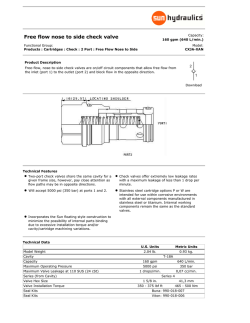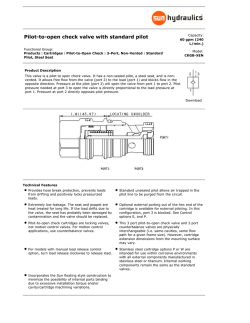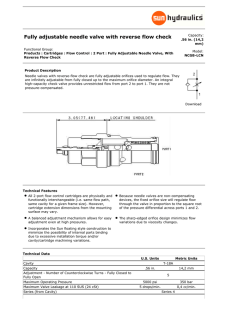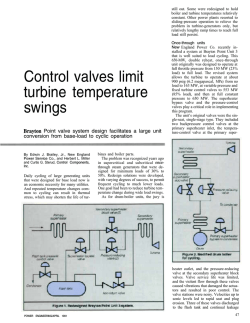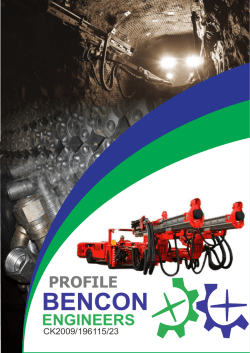
Hydraulic Manual - Sullivan Training Systems
The Secret of Hydraulic Schematics © 1997 - 2006 Sullivan Training Systems brighterIDEAS for Education & Training Sullivan w w .b w rig ht er id ea s. co m Table of Contents The Secret to Reading and Interpreting Hydraulic Schematics ................................................. 1 Hydraulic System Schematics ................................................................................................................ 1 Reservoirs ....................................................................................................................................................... 2 Hydraulic Lines, Tubes & Hoses ............................................................................................................. 3 .............................................................................................................3 Pumps .............................................................................................................................................................. 5 Hydraulic Motors ......................................................................................................................................... 7 Hydraulic Cylinders ..................................................................................................................................... 8 Area, Volume & Cycle Time ..................................................................................................................... 10 Pressure Control Symbols ....................................................................................................................... 11 Pressure Relief Valve ................................................................................................................................ 12 Sequence Valve ........................................................................................................................................... 13 Pressure Reducing Valve ......................................................................................................................... 14 Directional Control Valves ...................................................................................................................... 15 Two Position Flow Control Valves .......................................................................................................... 17 Three Position Flow Control Valves ..................................................................................................... 18 How Valves Are Actuated ...................................................................................................................... 19 Flow Control Mechanisms ...................................................................................................................... 20 Fluid Conditioning Mechanisms and Symbols .................................................................................. 21 Accumulators ............................................................................................................................................. 22 Miscellaneous Mechanisms and Symbols ........................................................................................ 23 Reading and Interpreting Hydraulic Schematic S ymbols Sullivan Brighter Ideas for Education & Training Page 1 The Secret to Reading and Interpreting Hydraulic System Schematics The secret to being successful at reading and interpreting a schematic for a hydraulic system is really quite simple. Very often, technicians will forget that the symbols on schematics are really a completely different language of pictographs — pictures of what the object does — used to represent the component. As you read this manual and begin to study the symbols inside, go to the extra effort to try and figure out why the symbols are drawn as they are. If you think about it, pumps will look like what pumps do, and all of the other symbols will come close to looking like what they are intended to be. As 1. 2. 3. you read the schematic, remember the following: You already have a good idea of what the machine does and how the components work. The schematic is a picture of the machine, which does what you understand. Therefore, whether it looks like it or not, the schematic and the machine match match. Don’t forget what you already know when you pick up a schematic — use what you know to force the schematic to make sense. Take the time to learn what the system is supposed to do. This is what a schematic is for — to teach why a system does what it does. If you get lost lost, remember that you always have to have fluid flowing, and as it flows it follows this path: starting at the pump, fluid flows from high pressure to low, and ends up back at the reservoir. Good luck. Reading and Interpreting Hydraulic Schematic Symbols Sullivan Brighter Ideas for Education & Training Page 1 Reservoirs Reservoirs are used to contain fluid, provide cooling, separate out air and sludge, and provide a head pressure to the pump if the reservoir is pressurized. VENTED RESERVOIR PRESSURIZED RESERVOIR PRESSURIZED RESERVOIR PRESSURIZED RESERVOIR Reservoirs can also be drawn to show the point of connection for suction and return lines. VENTED RESERVOIR OIL RETURN ABOVE OIL LEVEL VENTED RESERVOIR SUCTION LINE ATTACHED TO BOTTOM VENTED RESERVOIR OIL RETURN BELOW OIL LEVEL Reading and Interpreting Hydraulic Schematic Symbols Sullivan Brighter Ideas for Education & Training Page 2 Hydraulic Lines, Tubes & Hoses Hydraulic lines, tubes and hoses (or any other conductor) that carry the fluid between components is drawn as a line. PRESSURE OR RETURN LINE OIL FLOWS IN ONE DIRECTION PILOT LINES DRAIN LINES GASEOUS SUPPLY SHOWING DIRECTION OUTLINE FOR ENCLOSURE Reading and Interpreting Hydraulic Schematic Symbols OIL FLOWS IN BOTH DIRECTIONS FLEXIBLE LINE INSTRUMENT LINE Sullivan Brighter Ideas for Education & Training Page 3 Hydraulic Lines, Tubes & Hoses (continued) Connections for lines and hoses are shown below. Pay particular attention to the presence of a “dot” at the intersection of lines. If there’s no “dot” visible and lines cross, the lines do not connect. If lines intersect but one line ends, then even without a “dot” the lines do connect. LINES CONNECTED LINES CONNECTED LINES CONNECTED LINES NOT CONNECTED LINES NOT CONNECTED LINES NOT CONNECTED Reading and Interpreting Hydraulic Schematic Symbols Sullivan Brighter Ideas for Education & Training Page 4 Pumps Pumps are drawn as circles with triangles pointing outward from the center. The triangle represents the direction that fluid flows out of the pump and should be viewed as an arrow. A single arrow shows a one-direction (unidirectional) pump, while two arrows indicate a reversible (bidirectional) pump. A diagonal arrow cutting across the pump body indicates the pump displacement (output flow and volume) can be adjusted. A small rectangle on the side of the pump with a small arrow inside indicates that the pump output is compensated (adjusted or controlled) by a pressure signal from a pilot line. INLET FIXED DISPLACEMENT UNIDIRECTIONAL FIXED DISPLACEMENT REVERSIBLE OUTLET VARIABLE DISPLACEMENT Reading and Interpreting Hydraulic Schematic Symbols Sullivan VARIABLE DISPLACEMENT PRESSURE COMPENSATED Brighter Ideas for Education & Training Page 5 Pumps (continued) Pumps are also drawn to indicate how their output can be controlled. Note that the attachments to the pumps look like the components they represent. The lever and pedal look like a lever and pedal. The drive shaft is shown as a pair of lines on the side of the pump, either with or without an arrow showing the direction of rotation. Pumps can also be drawn as stacks, which indicates that all pumps are driven by the same driveshaft or PTO. LEVER CONTROLLED PEDAL CONTROLLED PUMP WITH DRIVE SHAFT DRIVE SHAFT SHOWING DIRECTION PUMP STACK Reading and Interpreting Hydraulic Schematic Symbols Sullivan Brighter Ideas for Education & Training Page 6 Hydraulic Motors Hydraulic motors are actually hydraulic pumps that work in reverse. Except for a few minor differences pumps and motors are virtually identical. Use the same rules to interpret motor symbols as you would pump symbols. OUTLET NON-REVERSIBLE MOTOR REVERSIBLE MOTOR INLET BI-DIRECTIONAL PRESSURE COMPENSATED Reading and Interpreting Hydraulic Schematic Symbols Sullivan MOTOR WITH DRIVE SHAFT Brighter Ideas for Education & Training Page 7 Hydraulic Cylinders Hydraulic cylinders convert fluid power to linear mechanical power. Fluid under pressure pushes against the ends of the piston to move it in order to move some other mechanism. Cylinders are drawn as rectangles with lines in the center to represent the piston piston, and lines through the ends to represent the rod rod. Fluid ports are shown on the outer ends of the cylinder barrel barrel. A single-acting cylinder only has one port so that fluid under pressure only enters one end and pushes only in one direction. The cylinder reverses by opening a valve to let gravity or a spring return the piston to the other end. A double-acting cylinder has ports at each end so pressurized fluid will enter both ends and push against the piston in both directions. PORT PISTON ROD BARREL TYPICAL HYDRAULIC CYLINDER Reading and Interpreting Hydraulic Schematic Symbols Sullivan Brighter Ideas for Education & Training Page 8 Hydraulic Cylinders (continued) SINGLE-ACTING CYLINDER DOUBLE-ACTING CYLINDER DOUBLE ROD-END CYLINDER DIFFERENTIAL CYLINDER SINGLE ROD END WITH A FIXED CUSHION AT BOTH ENDS Reading and Interpreting Hydraulic Schematic Symbols SINGLE ROD END WITH ADJUSTABLE CUSHION ON ROD END ONLY Sullivan Brighter Ideas for Education & Training Page 9 Area, Volume & Cycle Time The speed at which a cylinder moves is based upon the fluid flow rate (in gallons/minute or Cycle time cubic feet/minute) and the volume (displacement) of the piston. “Cycle time” is the time it takes a cylinder to move its full length, and is found by dividing the displacement of the cylinder (area x stroke) by the flow rate, then multiplying by 60 seconds seconds. Cycle time is critical in diagnosing a hydraulic problem. AREA Area = 3.14 x radius STROKE 2 VOLUME (CID) = Area x Stroke CYCLE TIME = (Volume/Flow Rate) x 60 150 cu. in. cylinder 450 cu. in. per minute flow x 60 sec = 0.333 x 60 = 20 sec Volume and Displacement are the same, and are found by multiplying area times length. When calculating cycle time, make sure you use the same units of measurement. Cubic feet per minute cannot be used with gallons, and vice versa. Reading and Interpreting Hydraulic Schematic Symbols Page 10 Sullivan Brighter Ideas for Education & Training Pressure Control Symbols Hydraulic pressure is controlled through the use of valves that open and close at different times to allow fluid to be bypassed from points of high pressure to points of low pressure pressure. The basic valve symbol is a square which represents the valve body or spool spool. An arrow in the center represents the path oil takes through the valve. Pressure control valves are typically pilot operated — that is, the valve is moved automatically by hydraulic pressure and not by a person. Pilot oil pressure is resisted by a spring, which can often be adjusted. The higher the spring tension, the more fluid pressure is required to move the valve valve. To visualize the operation of this type of valve, imagine that the entire square will move away from the pilot line and towards the spring. If the valve is normally-open normally-open, fluid flow will be cut off by the pilot line. If the valve is normally-closed normally-closed, the pilot line will cause oil to start flowing. Valves can either be on/off valves with no flow in the middle, or infinitely variable, which means flow will gradually increase or decrease as pilot pressure increases and/or decreases. SPRING INLET SPRING INLET PILOT LINE PILOT LINE OUTLET NORMALLY OPEN VALVE Reading and Interpreting Hydraulic Schematic Symbols OUTLET NORMALLY CLOSED VALVE Sullivan Brighter Ideas for Education & Training Page 11 Pressure Relief Valve A pressure relief valve is a normally closed valve that senses the high pressure at its inlet. As the pressure at the inlet increases, the pressure in the pilot line begins to push against the valve body (spool). As the valve body moves, the ports begin to line up and fluid will begin flowing through the relief valve. The relief valve typically dumps back into the reservoir. Most relief valves are infinitely variable. PRESSURE RELIEF VALVE Reading and Interpreting Hydraulic Schematic Symbols Sullivan Brighter Ideas for Education & Training Page 12 Sequence Valve A sequence valve is a normally closed valve that opens once the inlet pressure reaches a preset point. This type of valve is designed to allow different components to act “sequentially”, meaning one after the other. Once the primary actuator reaches the limit of its travel fluid pressure in the feed line will rise. This rising pressure opens the sequence valve which allows fluid to flow through it to the secondary cylinder. TO PRIMARY CYLINDER SEQUENCE VALVE TO SECONDARY CYLINDER Reading and Interpreting Hydraulic Schematic Symbols Sullivan Brighter Ideas for Education & Training Page 13 Pressure Reducing Valve A pressure reducing valve is a normally open valve that senses the outlet pressure going to an actuator. As the pressure in the outlet increases, pilot pressure increases which gradually closes the reducing valve. As the valve closes, oil from the high pressure side of the valve is directed back to the reservoir which dumps pressure at the outlet. OR PRESSURE REDUCING VALVE Reading and Interpreting Hydraulic Schematic Symbols PRESSURE REDUCING VALVE Sullivan Brighter Ideas for Education & Training Page 14 Directional Control Valves The direction that fluid flows in a line can be controlled by using valves which allow flow in only one direction. These valves are typically referred to as “check valves” because they “check” the flow if it tries to reverse. These valves can have simple check balls or can have machined poppet type valves. They can also be more complex pilot operated valves that have spools. ball. If In the case of a ball check valve, the allowed flow is opposite the arrow, or towards the ball the valve has no spring, the valve offers resistance to flow only in the “closed” direction; in the “open” direction the valve moves with any movement of fluid and does not have a pressure setting. If the check valve has a spring it will oppose flow in the “open” direction up to the point where hydraulic pressure overcomes spring tension. Check valves can also be pilot operated. NO FLOW FREE FLOW ONE WAY VALVE (CHECK VALVE) BY-PASS VALVE (SPRING LOADED CHECK VALVE) Reading and Interpreting Hydraulic Schematic Symbols PILOT OPERATED BY-PASS VALVE Sullivan Brighter Ideas for Education & Training Page 15 Directional Control Valves (continued) Another method of drawing check valves (directional valves) is using composite symbols as in the previous sequence. This method contains a blocked path and a free path. The dashed lines represent pilot pressure lines. As pressures increase on the blocked side of the valve, that pilot line moves the valve to reduce or cut off supply, depending upon whether the valve is normally open or closed. The spring keeps the valve in the normal position position. If pressure builds up on the flow side of the valve, the pilot line pressurizes and moves the valve into the open position, compressing the spring in the process, and allowing oil to flow. If the flow attempts to reverse, the other pilot line pressurizes and adds to spring pressure to close the valve, cutting off flow. These valves are commonly referred to as flow dividers or flow control valves. This type of valve can be a pressure relief valve or pressure reducing valve depending upon location of pilot source and spring setting. FREE FLOW NO FLOW ONE WAY VALVE SHOWN CLOSED PILOT PRESSURE FROM RIGHT PUSHES VALVE UPWARD TO ALLOW FLOW Reading and Interpreting Hydraulic Schematic Symbols Sullivan Brighter Ideas for Education & Training Page 16 Two Position Flow Control Valves Two position flow control valves typically are used to make the flow reverse to an actuator in a simple system, although other arrangements are possible. The valve spool slides long-ways to allow one or the other valve position to direct flow. Because these valves have no center position they must be used with a pressure relief valve that opens to dump system pressure when the actuator bottoms out. Note that the direction of oil flow does not change on the pump side of the valve valve. The direction changes only after the valve “flip-flops” the flow to redirect pressure to the retracted side of the cylinder. Reading and Interpreting Hydraulic Schematic Symbols Sullivan Brighter Ideas for Education & Training Page 17 Three Position Flow Control Valves Flow control valves are drawn as composite symbols using squares to represent the valve spool. To visualize the operation of these valves it’s necessary to imagine them moving longways with the spool sliding to move the different flow arrows into a position to allow oil to flow through them. The centers of the valves determine what type of system is in use. An “open center” system uses valves that allow oil to flow through them at all times — out of the pump and back into the reservoir — when no actuators are in use. This system does not require a pressure relief valve. A “closed center” system uses valves that block flow through them when no actuators are in use, thereby “liquid locking” the system. In this type of system a pressure relief valve is mandatory to prevent the system from destroying itself when the valves are in the center. OPEN CENTER VALVE & SYSTEM Reading and Interpreting Hydraulic Schematic Symbols CLOSED CENTER VALVE & SYSTEM WITH PRESSURE RELIEF VALVE Sullivan Brighter Ideas for Education & Training Page 18 How Valves Are Actuated There are a variety of ways to actuate control valves. These include manually by hand with a lever, manually by foot with a pedal, with an electric solenoid (coil), using external pilot pressure, using a spring, using internal pilot pressure, or using any combination of the above. LEVER CONTROLLED SOLENOID CONTROLLED PEDAL CONTROLLED (NOT JUST ON AND OFF) PILOT PRESSURE CONTROLLED SOLENOID OPERATED WITH INTERNAL PILOT PRESSURE SOLENOID OPERATED WITH INTERNAL PILOT PRESSURE AND SPRING CENTERING INFINITELY VARIABLE Reading and Interpreting Hydraulic Schematic Symbols Sullivan Brighter Ideas for Education & Training Page 19 Flow Control Mechanisms Sometimes it’s necessary to slow down flow or to create a pressure drop at some point in the system. This is done with a restrictor (snubber) that is similar to a fuel jet. Snubbers are drawn to represent a pinch in the line, and can either be fixed or variable, and can be controlled by other systems as well — such as being temperature or pressure controlled. FIXED RESTRICTOR ADJUSTABLE RESTRICTOR ADJUSTABLE RESTRICTOR PRESSURE COMPENSATED ADJUSTABLE RESTRICTOR PRESSURE & TEMPERATURE COMPENSATED Reading and Interpreting Hydraulic Schematic Symbols Sullivan Brighter Ideas for Education & Training Page 20 Fluid Conditioning Mechanisms and Symbols Oil is conditioned by various mechanisms. “Conditioned” implies that the condition of the oil is changed from one state to another. Typical conditioners are filters, heaters and coolers. In addition, these mechanisms can contain drains of various sorts. FILTER OR STRAINER COOLER HEATER TEMPERATURE CONTROL UNIT MANUAL DRAIN SEPARATOR AUTO DRAIN SEPARATOR MANUAL DRAIN FILTER SEPARATOR AUTO DRAIN FILTER SEPARATOR Reading and Interpreting Hydraulic Schematic Symbols Sullivan Brighter Ideas for Education & Training Page 21 Accumulators Hydraulic accumulators act as shock absorbers for the system. They are installed in parallel with the pump and do several things. They provide a small amount of emergency flow for steering and brakes, dampen out oscillations in pressure (keeping pressure constant), and provide flow when components move and activate. They’re drawn as ovals with a line in the center which represents the diaphragm or piston that separates the oil from the nitrogen or spring. PNEUMATIC (GAS FILLED) ACCUMULATOR Reading and Interpreting Hydraulic Schematic Symbols SPRING LOADED ACCUMULATOR Sullivan Brighter Ideas for Education & Training Page 22 Miscellaneous Mechanisms and Symbols QUICK DISCONNECTS (CONNECTED) PRESSURE SWITCH TEST POINT FOR GAUGE QUICK DISCONNECTS (DISCONNECTED) SPRING RATCHETING DETENT ON VALVE MANUAL SHUTOFF VALVE TEMPERATURE INDICATOR PRESSURE INDICATOR Reading and Interpreting Hydraulic Schematic Symbols Sullivan Brighter Ideas for Education & Training Page 23 ©1997 - 2006 Sullivan Training Systems 115 Honeysuckle Lane Durham NC 27703 919-957-1800 www.brighterideas.com brighterIDEAS in Technician Training This text may be reproduced for training purposes by any person or school provided that it is duplicated in its entirety, complete with all logos and identifying marks. Modification of this document in any way constitutes a violation of this agreement. Please visit our wesbite to view the new tools and texts currently available. Feel free to email this document at will to friends and colleagues who work with hydraulics.
© Copyright 2025
